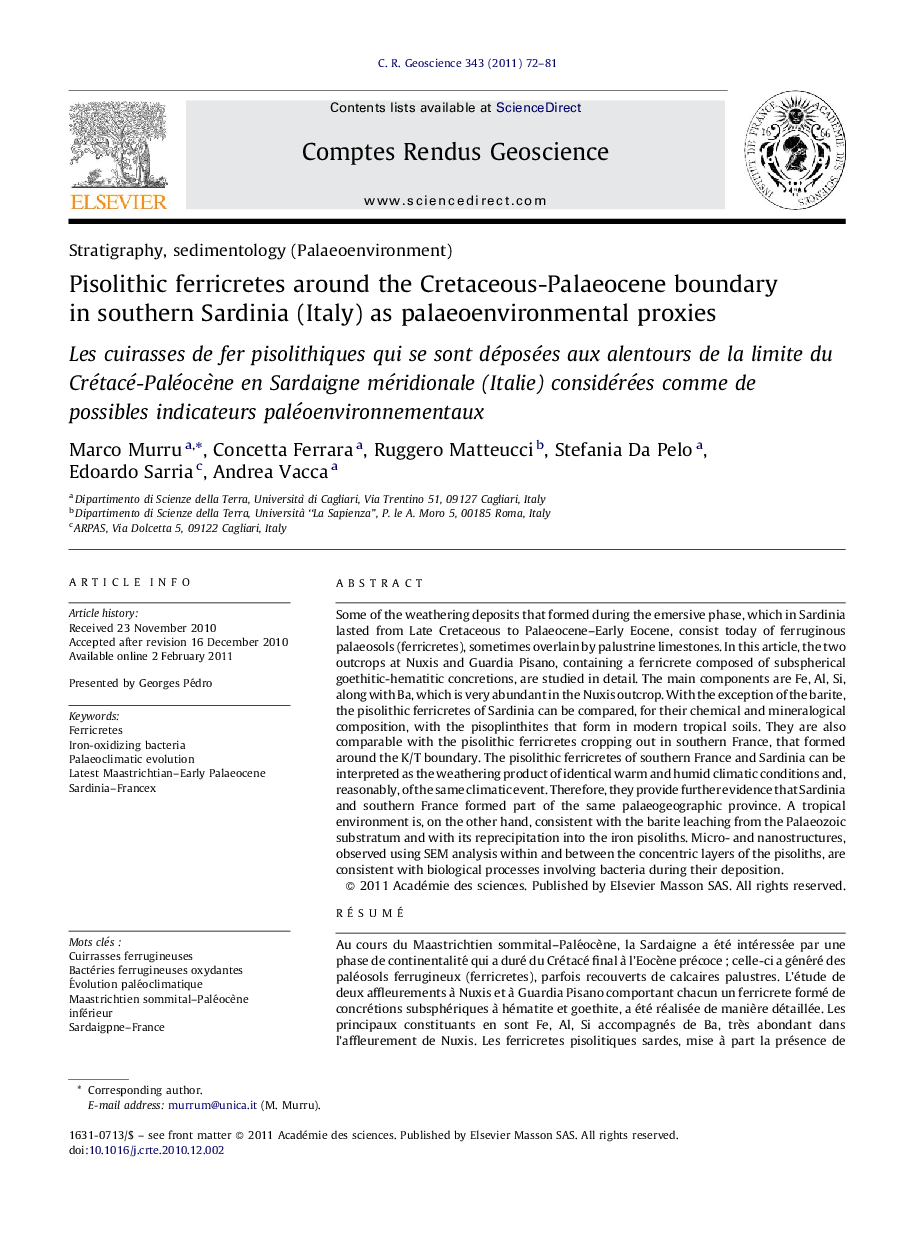| Article ID | Journal | Published Year | Pages | File Type |
|---|---|---|---|---|
| 4462699 | Comptes Rendus Geoscience | 2011 | 10 Pages |
Some of the weathering deposits that formed during the emersive phase, which in Sardinia lasted from Late Cretaceous to Palaeocene–Early Eocene, consist today of ferruginous palaeosols (ferricretes), sometimes overlain by palustrine limestones. In this article, the two outcrops at Nuxis and Guardia Pisano, containing a ferricrete composed of subspherical goethitic-hematitic concretions, are studied in detail. The main components are Fe, Al, Si, along with Ba, which is very abundant in the Nuxis outcrop. With the exception of the barite, the pisolithic ferricretes of Sardinia can be compared, for their chemical and mineralogical composition, with the pisoplinthites that form in modern tropical soils. They are also comparable with the pisolithic ferricretes cropping out in southern France, that formed around the K/T boundary. The pisolithic ferricretes of southern France and Sardinia can be interpreted as the weathering product of identical warm and humid climatic conditions and, reasonably, of the same climatic event. Therefore, they provide further evidence that Sardinia and southern France formed part of the same palaeogeographic province. A tropical environment is, on the other hand, consistent with the barite leaching from the Palaeozoic substratum and with its reprecipitation into the iron pisoliths. Micro- and nanostructures, observed using SEM analysis within and between the concentric layers of the pisoliths, are consistent with biological processes involving bacteria during their deposition.
RésuméAu cours du Maastrichtien sommital–Paléocène, la Sardaigne a été intéressée par une phase de continentalité qui a duré du Crétacé final à l’Eocène précoce ; celle-ci a généré des paléosols ferrugineux (ferricretes), parfois recouverts de calcaires palustres. L’étude de deux affleurements à Nuxis et à Guardia Pisano comportant chacun un ferricrete formé de concrétions subsphériques à hématite et goethite, a été réalisée de manière détaillée. Les principaux constituants en sont Fe, Al, Si accompagnés de Ba, très abondant dans l’affleurement de Nuxis. Les ferricretes pisolitiques sardes, mise à part la présence de baryum, peuvent êtres comparés, quant à leur composition minéralogique et chimique, aux pisoplinthites qui se forment dans les sols tropicaux modernes et aussi aux ferricretes pisolitiques, formés à la limite K/T dans le Sud de la France. Les ferricretes pisolitiques du Sud de la France et de Sardaigne peuvent être interprétés comme des produits d’altération développés dans des conditions identiques humides et chaudes et raisonnablement issus du même évènement climatique. Ceci serait la preuve que le Sud de la France et la Sardaigne ont fait partie de la même province paléogéographique à la limite K/T. Par ailleurs, ces conditions environnementales expliqueraient la dissolution de la baryte du substrat paléozoïque, puis l’incorporation du baryum dans les pisolithes ferrugineux. L’examen au microscope électronique à balayage de micro- et nanostructures de pisolithes évoque la présence de bactéries, ce qui implique l’intervention de processus biologiques dans la formation des pisolithes ferrugineux.
